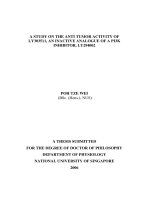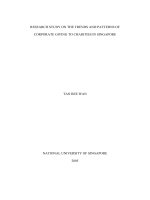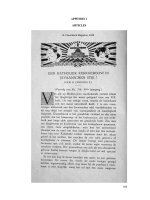STUDY ON THE QUASI - ZERO STIFFNESS VIBRATION ISOLATION SYSTEM - Full 10 điểm
Bạn đang xem bản rút gọn của tài liệu. Xem và tải ngay bản đầy đủ của tài liệu tại đây (5.87 MB, 186 trang )
MINISTRY OF EDUCATION AND TRAINING
HO CHI MINH CITY UNIVERSITY OF TECHNOLOGY AND EDUCATION
VO NGOC YEN PHUONG
“STUDY ON THE QUASI-ZERO STIFFNESS VIBRATION
ISOLATION SYSTEM”
MAJOR: MECHANICAL ENGINEERING
MAJOR CODES: 9520103
THE DOCTORAL THESIS
Ho Chi Minh City, Mar/ 2022
MINISTRY OF EDUCATION AND TECHNOLOGY
HO CHI MINH CITY UNIVERSITY OF TECHNOLOGY AND EDUCATION
VO NGOC YEN PHUONG
“STUDY ON THE QUASI-ZERO STIFFNESS VIBRATION
ISOLATION SYSTEM”
MAJOR: MECHANICAL ENGINEERING
MAJOR CODES: 9520103
SCIENTIFIC SUPERVISORS
1. Assoc. Prof. Dr. LE THANH DANH
2. Dr. NGUYEN MINH KY
1. Reviewer 1:
2. Reviewer 2:
3. Reviewer 3:
Ho Chi Minh City, May / 2021
LÝ LỊCH KHOA HỌC
(Dùng cho nghiên cứu sinh & học viên cao học)
I. LÝ LỊCH SƠ LƯỢC:
Họ & tên: VÕ NGỌC YẾN PHƯƠNG
Giới tính: Nữ
Ngày, tháng, năm sinh: 11/08/1983
Nơi sinh: TP.HCM
Quê quán: Củ chi, TP.HCM
Dân tộc: Kinh
Chức vụ, đơn vị công tác trước khi học tập, nghiên cứu:
Giảng viên Khoa Cơ Khí, Trường Đại học Cơng Nghiệp TP.HCM
Chỗ ở riêng hoặc địa chỉ liên lạc: Ấp Gò Nổi A, Xã An Nhơn Tây, Huyện Củ Chi,
TP.HCM
Điện thoại cơ quan:
Điện thoại nhà riêng:
Fax:
E-mail:
II. QUÁ TRÌNH ĐÀO TẠO:
1. Trung học chuyên nghiệp:
Hệ đào tạo:
Thời gian đào tạo từ ……/…… đến ……/ ……
Nơi học (trường, thành phố):
Ngành học:
2. Đại học:
- Hệ đào tạo: Chính quy
Thời gian đào tạo từ 09/2001 đến 05/2006
Nơi học (trường, thành phố): Trường Đại học Sư Phạm Kỹ Thuật TP.HCM,
TP.HCM.
Ngành học: Kỹ Thuật Công Nghiệp
Tên đồ án, luận án hoặc môn thi tốt nghiệp: Thiết kế, chế tạo máy chuốt đũa đôi tự
động.
i
Ngày & nơi bảo vệ đồ án, luận án hoặc thi tốt nghiệp: 01/09/2005, Khoa Cơ Khí chế
tạo máy, trường Đại học Sư Phạm Kỹ Thuật TP.HCM, TP.HCM.
Người hướng dẫn: KS. Nguyễn Văn Hồng
- Hệ đào tạo: Vừa học vừa làm
Thời gian đào tạo từ 09/2003 đến 05/2008
Nơi học (trường, thành phố): Trường Đại học Khoa học Xã hội & Nhân văn
TP.HCM.
Ngành học: Ngữ Văn Anh
Bẳng tốt nghiệp: Cử nhân
3. Thạc sĩ:
Hệ đào tạo: Chính quy
Thời gian đào tạo từ 09/2007 đến 01/ 2010
Nơi học (trường, thành phố): Trường Đại học Bách Khoa TP.HCM, TP.HCM
Ngành học: Chế tạo máy
Tên luận văn: Chế tạo anode bảo vệ Cathode dịng điện ngồi ứng dụng trong các
cơng trình biển.
Ngày & nơi bảo vệ luận văn: 12/01/2010, Khoa Cơ Khí, Trường Đại học Bách Khoa
TP.HCM, TP.HCM
Người hướng dẫn: TS. Lưu Phương Minh
4. Tiến sĩ:
Hệ đào tạo:
Thời gian đào tạo từ ……/…… đến ……/ ……
Tại (trường, viện, nước):
Tên luận án:
i
Người hướng dẫn:
Ngày & nơi bảo vệ:
5. Trình độ ngoại ngữ (biết ngoại ngữ gì, mức độ):
Cử nhân Ngành Ngữ Văn Anh, Khá
6. Học vị, học hàm, chức vụ kỹ thuật được chính thức cấp; số bằng, ngày & nơi cấp:
III. Q TRÌNH CƠNG TÁC CHUN MƠN KỂ TỪ KHI TỐT NGHIỆP ĐẠI
HỌC:
Nơi công tác
Thời gian
09/2012 đến
nay
Công việc đảm nhiệm
Trường Đại học Cơng Nghiệp
TP.HCM
Giảng viên
IV. CÁC CƠNG TRÌNH KHOA HỌC ĐÃ CƠNG BỐ:
TT
Tên cơng trình
(bài báo, cơng trình...)
Là tác giả
hoặc
là đồng tác
giả
Nơi cơng bố
(tên tạp chí đã đăng)
Năm
cơng
bố
cơng trình
1
Tạp chí quốc tế
Adaptive pneumatic
isolation platform.
vibration Tác giả
i
Mechanical Systems 2019
and Signal processing
(Q1)
2
Static analysis of low frequency Tác giả
Isolation model using pneumatic
cylinder with auxiliary chamber.
International
2020
Symposium
on
Precision Engineering
and
Sustainable
Manufacturing (Q2)
Dynamic Stiffness Analysis of a Tác giả
Nonlinear Vibration Isolation
Model with symmetrical and
Quasi-Zero
Stiffness
Characteristics
Journal of Polimesin
Analysis model of restoring force Tác giả
of a rubber air spring
Journal
Vibroengineering
(ESCI-Scopus).
Analytical study of a pneumatic Tác giả
vibration
isolation
platform
featuring adjustable stiffness
Commun Nonlinear 2021
Sci Numer Simulat
(Q1)
Dynamic Analysis of Quasi-Zero Tác giả
Stiffness Pneumatic Vibration
Isolator
Journal of
Sciences.
of 2021
Applied 2022
Tạp chí quốc gia
Dynamic stiffness analysis and Tác giả
isolation effectiveness of vibration
isolation
platform
using
pneumatic spring with auxiliary
chamber.
3
2021
Journal of Technical 2019
education science
Hội nghị quốc tế
Modeling and Simulation of low Đồng
frequency vibration isolation giả
table.
i
tác Proceeding of the First 2018
Conference
on
Material,
Machines
and
Methods
of
sustainable
Development.
4
Effects
of
configuration Tác giả
parameters on the dynamic
stiffness
and
stability
of
pneumatic vibration isolation
model.
International
2018
Conference on Fluid
Machinery
and
Automation System.
Study
on
Vibration Tác giả
Transmissibility Characteristic of
a novel asymmetric nonlinear
model using pneumatic spring,
IEEE
International 2019
Conference on System
Science
and
Engineering.
Identification of friction force Tác giả
model of a pneumatic cylinder
IEEE
International 2021
Conference on System
Science
and
Engineering.
Đề tài nghiên cứu khoa học
Phân tích động học của bộ cách ly Chủ nhiệm
dao động phi tuyến không đối
xứng
XÁC NHẬN CỦA CƠ QUAN CỬ ĐI HỌC
(Ký tên, đóng dấu)
T2020-05NCS, Trường 2021
ĐHSPKT TPHCM
Ngày
tháng
năm 2022
Người khai ký tên
Võ Ngọc Yến Phương
i
ORIGINALITY STATEMENT
“I hereby declare that this submission is my own work, done under the supervision
of Assoc. Prof. Dr. Le Thanh Danh and Dr. Nguyen Minh Ky, and all the best of my
knowledge, it contains no illegal materials previously published or written by another
person.”
Ho Chi Minh City, Mar. 9th 2022
Vo Ngoc Yen Phuong
ii
ACKNOWLEDGEMENT
This dissertation was put down in writing from 2018 to 2021 during my time as a
Doctor of Philosophy Candidate at the Mechanical Engineering Faculty at Ho Chi Minh
City University of Technology and Education. I would like to express my deep gratitude
to Assoc. Prof. Dr. Le Thanh Danh for bestowing me the opportunity to take part in his
research group as well as for his conscientious instruction as my principal doctoral mentor.
Simultaneously, he let me experience my independent study and he always supervised
carefully during my research schedule.
Besides, I also want to thank Dr. Nguyen Minh Ky from the Faculty of Mechanical
Engineering of HCMC University of Technology and Education for his devotion as a cosupervisor for my PhD thesis.
I would like also to acknowledge the National Foundation for Science and
Technology Development (NAFOSTED, Vietnam) and Ho Chi Minh City University of
Technology and Education for their financial assistance throughout my research project.
Thanks to their interest, this thesis has been accomplished on time.
I am really grateful to my colleagues at Mechanical Engineering Faculty at Industrial
University of Ho Chi Minh City for their friendly supports. In addition, I would like to
appreciate the lecturers at Mechanical Engineering Faculty at University of Technology
and Education for their meaningful assistance.
Finally, I express my thanks to my family, especially my mother, my husband and my
two daughters for their emotional encouragement throughout my study.
Ho Chi Minh City, Feb. / 2022
Vo Ngoc Yen Phuong
iii
ABSTRACT
The thesis of “Study on the quasi-zero stiffness vibration isolation system” is
presented in six chapters.
The thesis introduces an innovation quasi-zero stiffness adaptive vibration isolation
model (QSAVIM) composed by semicircular CAM-wedge-pneumatic spring mechanism.
One with the positive stiffness including the wedges, the rollers and the two rubber air
springs, is used to support the load. The other comprising the semi-circular cams, the
rollers and other air springs, whose stiffness is negative, is employed to adjust the system
stiffness. In this model, a component which is non-steel elastic element is the pneumatic
spring including rubber air spring and pneumatic cylinder are employed respectively in
the proposal model.
The restoring model of a commercial rubber air spring is analyzed and developed,
which is contributed by three factors including compressed air, friction and
viscoelasticity of the rubber bellow. Herein, the nonlinear hysteresis model of the rubber
tube is also considered. Then, an experimental rig is set up to identify and verify the
parameters of the rubber air spring model. In addition, the friction force of the pneumatic
cylinder is also investigated through using virtual prototyping technology.
The complex nonlinear dynamic response of the quasi-zero stiffness adaptive
vibration isolation model which is a parallel connection between a load bearing
mechanism and a stiffness corrected one is realized. The important feature of the
proposed model is that it is easy not only to adjust the stiffness to adapt according to the
change of the isolated mass but to improve the isolation effectiveness in low frequency
region that is useful in practical application. The studied results show that the
effectiveness of the proposed model is much better than the equivalent traditional model.
iv
CONTENTS OF THESIS
Cover page
Page
Approval of PhD thesis topic
Curriculum vitae
i
Originality statement
ii
Acknownledgement
iii
Abstract
iv
Contents
v
Nomenclature
vi
List of figures
vii
List of tables
viii
Abbreviation
ix
CHAPTER 1: INTRODUCTION……………………………………………………….. 10
1.1 The necessity of vibration isolation………………………………………………….…...10
1.2 The aim of the research………………………………………………………………….. …...10
1.3 Problems are needed solutions………………………………………………...11
1.4 Research scope and object: ……………………………………………... …...11
1.5 Research approach………………………………..................................... …...11
1.6 Contributions of thesis ………………………………………………….…….12
1.7 Content of thesis……………………………………………………………....13
1.8 The obtained results…………………………………………………..…….....14
1.9 The scientific and application contribution of the thesis:………………..........14
CHAPTER 2: LITERATURE REVIEWS……………………………………………….……15
2.1. Vibration Isolation……………………………………………………………...15
v
2.2. Models of present vibration isolation………………………………………....17
2.2.1. Isolated model using Euler spring……………………………………17
2.2.2. Isolated model featuring quasi-zero stiffness characteristic …………19
CHAPTER 3: FUNDAMENTAL OF RELATIVE THEORIES…………………………......37
3.1. Air spring……………………………………………………………………………...37
3.1.1. Introduction……………………………………………………………..….37
3.1.2. General structure of rubber bellow ………………………………………...38
3.2. Mathematical model of the compressed air……..…………………………………….40
3.3. Frictional model of pneumatic cylinder and rubber material………..……………...…41
3.3.1. Frictional model of pneumatic cylinder…………………………………...41
3.3.2. Frictional model of rubber material……………………………………….42
3.4. Viscoelastic model of rubber bellow…………………………………………..………43
3.5. Normal form method……………………………………………………………..……44
3.6. Multi scale method…………………………………………………………………….46
3.7. Runge-kutta method………………………………………………………………...…47
3.8. Poincaré section…………………………………………………………………….....48
3.9. Brief introduction of Genetic Algorithm [58]…………………………………..50
CHAPTER 4: QUASI-ZERO STIFFNESS VIBRATION ISOLATOR USING A RUBBER
AIR SPRING………………........................................................................................................53
4.1. Mechanical model of proposed isolator……..…………………………………….53
4.2. Restoring model of rubber air spring. ……..……………………………………...58
v
4.2.1 Compressed air force…………………………………………….…..57
4.2.2. Frictional force……………………………………………….……..58
4.2.3. Viscoelastic force……………………………………………….…..58
4.2.4. Test rig ………………………………………………………….….59
4.2.5. Model identification and verification results…………….….……...61
4.3. Static analysis of the isolator ………………………………………………...67
4.3.1. Stiffness model …………………………………………………..…64
4.3.2. Analysis of equilibrium position ……………...…………………....67
4.4. Design procedure for obtaining quasi-zero stiffness isolator ………………..71
4.5. Dynamic analysis…………………………………………….………………73
4.5.1. Equation of Dynamic …………………………………………….…..73
4.5.2. Equation of vibration transmissibility………………………………..74
4.6 Effects of configurative parameters on vibration transmissibility curve……..78
4.6.1 Influence of pressure ratio on the shape of the amplitude-frequency
response curve…………………………………………….………………...78
4.6.2 Influence of geometrical parameters on the resonant peak…………....82
4.6.3 Effects of damping on vibration transmissibility curve……...…….….84
4.7. Complex dynamic analysis…………………………………………………...85
4.7.1. Frequency jump phenomenon ……………………………………..…85
v
4.7.2. Bifurcation phenomenon …………………………………………...87
4.7.3. Dynamic response under random excitation………………………..89
4.8. Experimental result and apparatus……………………………………………91
CHAPTER 5: QUASI-ZERO STIFFNESS ADAPTIVE VIBRATION ISOLATION
MODEL USING A PNEUMATIC CYLINDER……………………………………...99
5.1. Model of QSAVIM using a PC……………….……………………………..99
5.2. Pneumatic cylinder with auxiliary chamber …….………………………….101
5.2.1. Pressure change………………….……………………………......101
5.2.2. Frictional model…………………………………………………..105
5.3. Stiffness of the modified model………………………………………….…108
5.4 Stiffness analysis of the LBM and SCM……………………………….…….111
5.5 Stiffness analysis of the modified model…………………………………….121
5.6 The analysis of equilibrium position ………………………………………..126
5.7. Dynamic analysis…………………………………………………………...133
5.7.1. Frequency-amplitude relation……………………………………..133
5.7.2. Stability of the steady state solution………………………………138
5.7.3. Transmissibility for force excitation……………………………….139
5.8. Numerical simulation…………………………………………………………140
5.8.1. Influence of parameters on the force transmitted curve……………140
5.8.2. Complex dynamic analysis………………………………..………146
v
CHAPTER 6: CONCLUSIONS AND FUTURE WORKS ………………………………...155
6.1 Conclusion………………………………………………………………………….155
6.2 Future works…………………………………………………………………..……156
Published papers ……………………………………………………………………………...158
Reference…………………………………………………………………………………..…..160
v
NOMENCLATURE
Latin letters
Ae
Effective area
Awh
Effective area of the rubber air spring at the working height
cp
Specific heat capacity at constant pressure
cv
Specific heat capacity at constant volume
D
Dissipation function
E
Energy
EK
Kinetic Energy
Ep
Potential Energy
F
Force
Fair
Air compressed force
Ff
Frictional force
Fvie
Viscoelastic force
Fras
Restoring force of rubber air spring
FLMB
Restoring force of load bearing mechanism
FSCM
Restoring force of stiffness corrected mechanism
Fs
Restoring force of the QSAVIM
Fsf
Sliding frictional force
Fef
External force
Gin
Mass low rates at inlet.
Gout
Mass low rates at outlet.
g
Acceleration of gravity
H0
Static vertical deformation of the QSAVIM
vi
h
Height of the cylinder
Kras
Stiffness of rubber air spring
KDSEP
Stiffness at the DSEP
mair
Mass of the air in the pneumatic working chamber
M
Mass of the isolated load
n
Ratio of specific heat capacity.
ns
Exponent of the Stribeck curve
Ps
Pressure of the air in the cylinder
Patm
Atmosphere pressure
Pwh
Pressure of the rubber air spring at the working height
Pac
Pressure of air in the auxiliary chamber
Pcy
Pressure in pneumatic cylinder
Pso
Pressure in the cylinder at the initial position
Ps
Supply pressure
Pwh
Absolute pressure of rubber air spring at the working height
R
Radius of the semicircular cam
Rair
Gas constant
r
Radius of the roller
T
Temperature of the air in the pneumatic working chamber
Ta
Displacement transmissibility
TF
Force Transmissibility
Tin
Temperature of air at the inlet
u
Relative displacement between the load plate and base
vi
v
Velocity
vs
Stribeck velocity
Ve
Effective volume
Vac
Volume of auxiliary chamber
Vwh
Effective volume of the rubber air spring at the working height
x
Arbitrary positions of the rubber air spring
xwh
Positions of the rubber air spring at the working height
y
Displacement of the load plate from undeformed state to arbitrary
position
ze
Excitation
z
Absolute displacement of the load plate
Greek letters
α
Incline angle of the wedge
µ
Pressure ratio
ω
Natural frequency
n
the natural frequency in rad/s
α ht
the heat transfer coefficient
a
the heat transfer surface area,
the viscous friction coefficient,
Subscripts
ef
External force
F
Force
LBM
Load bearing mechanism
ras
Rubber air spring
vi
s
Spring
sf
Sliding force
SCM
Stiffness corrected mechanism
vie
Viscoelasticity
wh
Working height
Superscripts
- or
Dimensionless quantity
•
Time derivative
Dimensionless time derivative
vi









